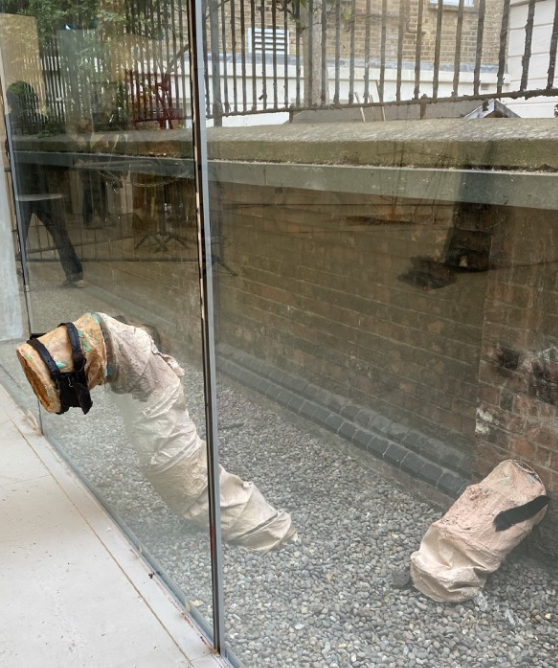I learned on my cat,
burying her head in the crack
I learned on my cat, burying her head in the crack
photograph
April 2022
photograph
April 2022

Conjugacy
silicone, fibre, wire
July 2022
silicone, fibre, wire
July 2022


1: Strangers, strange spaces, strange smells, doctors, purring from other cats, dog’s barking...
2: language, strangers, socialising, new rules, schedules, toxic relationship, washing machines that never dry clothes, smelly clothes, corrections, keeping social distance, stagnant artistic ideas, the depth of thought required to burn expensive 17 pounds cigarettes...
1 is the stress of my cat who, when I take her to the hospital, chooses to curl up in a ball and bury her head in my armpits. 2 is my stress, I learned with my cat, burying her head in all the crevices of life in a new environment.
Ostriches will bury their heads in the sand when they are scared or threatened. They believe that if they can't see the danger they are safe. Although this is a fallacy, they do not live in this way. The ostrich effect, also known as the ostrich problem, is a form of loss aversion, mainly applied to economics as psychology describes how people often avoid negative information. Instead of dealing with the situation, we bury our heads in the sand like an ostrich. This avoidance often makes things worse, generating costs that we might not have to pay if we faced things head on.
In the work conjugacy, I identify the hidden head with the blinker horse, which limits the horse's movement. In my opinion, the blinker horse limits the horse's perspective to the front by physically, isolating it from the realisation, allowing it to just run in front. This is similar to the ostrich mentality and escapism of those who bury their heads in the cracks, everyone's escapist behaviour is impacted by the ‘blinker horse’ in the outside world, 'blinker horse' on human world may be advertisement, beauty magazine, YouTubers, grade, success .....
The title of the piece is conjugacy, which refers to the connection between the brain and the act of gazing in which the brain is impacted by pictures coming in via our eyes and also guides the eyes to avoid these realities, to avoid what we don't want to see. I opted to guide audiences put their head into a neck made of silicone that replicates the colour and texture of human flesh, which is buried in the structure, stretches out from somewhere, and is buried again in the wall/floor.
![]()
2: language, strangers, socialising, new rules, schedules, toxic relationship, washing machines that never dry clothes, smelly clothes, corrections, keeping social distance, stagnant artistic ideas, the depth of thought required to burn expensive 17 pounds cigarettes...
1 is the stress of my cat who, when I take her to the hospital, chooses to curl up in a ball and bury her head in my armpits. 2 is my stress, I learned with my cat, burying her head in all the crevices of life in a new environment.
Ostriches will bury their heads in the sand when they are scared or threatened. They believe that if they can't see the danger they are safe. Although this is a fallacy, they do not live in this way. The ostrich effect, also known as the ostrich problem, is a form of loss aversion, mainly applied to economics as psychology describes how people often avoid negative information. Instead of dealing with the situation, we bury our heads in the sand like an ostrich. This avoidance often makes things worse, generating costs that we might not have to pay if we faced things head on.
In the work conjugacy, I identify the hidden head with the blinker horse, which limits the horse's movement. In my opinion, the blinker horse limits the horse's perspective to the front by physically, isolating it from the realisation, allowing it to just run in front. This is similar to the ostrich mentality and escapism of those who bury their heads in the cracks, everyone's escapist behaviour is impacted by the ‘blinker horse’ in the outside world, 'blinker horse' on human world may be advertisement, beauty magazine, YouTubers, grade, success .....
The title of the piece is conjugacy, which refers to the connection between the brain and the act of gazing in which the brain is impacted by pictures coming in via our eyes and also guides the eyes to avoid these realities, to avoid what we don't want to see. I opted to guide audiences put their head into a neck made of silicone that replicates the colour and texture of human flesh, which is buried in the structure, stretches out from somewhere, and is buried again in the wall/floor.


